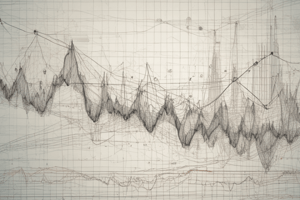Podcast
Questions and Answers
What does variance provide insights into in data analytics?
What does variance provide insights into in data analytics?
- Frequency of data points
- Central tendency of data points
- Variability and spread of data points (correct)
- Total number of data points
How does variance contribute to insightful decision-making in data analytics?
How does variance contribute to insightful decision-making in data analytics?
- By disregarding the range of data points
- By considering only the maximum value
- By focusing solely on the median value
- By examining the dispersion of data points around a mean value (correct)
What role does variance play in identifying trends and patterns in data?
What role does variance play in identifying trends and patterns in data?
- Disregarding outliers
- Detecting deviations from normalcy (correct)
- Ignoring historical trends
- Focusing solely on central tendencies
How does variance analysis assist in outlier detection?
How does variance analysis assist in outlier detection?
Why is variance essential in both descriptive and inferential statistical analyses?
Why is variance essential in both descriptive and inferential statistical analyses?
How does variance help analysts make accurate predictions from data?
How does variance help analysts make accurate predictions from data?
What is the formula used to calculate population variance?
What is the formula used to calculate population variance?
Why is calculating population variance often impossible?
Why is calculating population variance often impossible?
What does sample variance estimate?
What does sample variance estimate?
Which type of variance helps normalize values across different scales?
Which type of variance helps normalize values across different scales?
What technique involves analyzing basic statistics like mean, median, and mode?
What technique involves analyzing basic statistics like mean, median, and mode?
Which technique investigates why certain patterns in the data occur?
Which technique investigates why certain patterns in the data occur?
Flashcards are hidden until you start studying
Study Notes
Variance in Data Analytics
Variance is a fundamental concept in data analytics that provides insights into the variability and spread of data points. By understanding the variance within a dataset, analysts can identify trends, patterns, and outliers, helping them make accurate predictions and derive meaningful insights from the data. Variance is essential in both descriptive and inferential statistical analyses, enabling researchers to quantify the uncertainty and validity of their findings.
Importance of Variance in Data Analytics
Variance plays a critical role in data analytics for several reasons:
-
Insightful Decision Making: Variance helps analysts to examine the dispersion of data points around a mean value, providing essential input for decision-making processes. By understanding the range and spread of data, analysts can recognize potential issues and opportunities within the data.
-
Identifying Trends and Patterns: Variance is instrumental in detecting deviations from normalcy, which can indicate emerging trends or hidden patterns in the data. By comparing the variances across different periods, analysts can track changes and develop predictions based on historical trends.
-
Outlier Detection: Variance analysis enables the identification of extreme values that lie outside the expected range. These outliers can significantly impact the average and standard deviation of the data, potentially skewing the results. Detecting and addressing outliers prevents distorted analysis.
-
Quality Control: In production environments, variance is used to monitor the performance of processes and ensure consistent quality standards. By tracking the variation in process parameters, analysts can pinpoint potential defects and rectify issues to maintain quality control.
-
Optimizing Processes: Variance analysis allows for the identification of sources of variation and helps organizations focus on eliminating unnecessary variability. Streamlining operations reduces waste, improves efficiency, and ultimately enhances overall productivity.
Types of Variance
There are three main types of variance in data analytics:
-
Population Variance: Also known as the total variance or variance of the entire dataset, population variance is calculated using the formula
σ²(sigma squared), whereσrepresents the standard deviation of the population. However, calculating population variance requires access to the complete set of data, which is often impossible due to size constraints. -
Sample Variance: Sample variance is a simplified version of population variance, calculated using the formula
S², whereSis the sample standard deviation. Sample variance estimates the population variance by selecting a random subset of data (sample) and using the variance calculated from the sampled data to approximate the true population variance. -
Relative Variance: Relative variance, also known as coefficient of variation (CV), helps normalize the variance values across different scales. It is calculated using the formula
Cv = σ / μ, whereσrepresents the standard deviation andμrepresents the mean value. CV expresses the relative dispersion of data points around the average value.
Variance Analysis Techniques
Various techniques are employed to analyze variance and extract valuable insights:
-
Descriptive Statistical Analysis: This involves analyzing basic statistics like mean, median, mode, variability, frequency, and position to describe and summarize the data. Descriptive statistical analysis generates simple summaries about samples and measurements.
-
Diagnostic Analysis: This technique takes initial findings from descriptive analysis and investigates why certain patterns in the data occur. Diagnostic analysis often involves examining additional data sources, including historical data, to reveal more insights into current data trends.
-
Exploratory Data Analysis (EDA): EDA explores the data to find relationships between variables, using techniques like correlation analysis and scatterplot matrices. It helps discover new connections and form hypotheses, driving design planning and data collection.
-
Inferential Statistics: Inferential analysis uses a small sample of data to infer information about a larger population of data. It involves making assumptions about the population parameters based on the sample data, providing insights into statistical uncertainty and validity.
By leveraging these variance analysis techniques, data analysts and scientists gain a deeper understanding of their datasets, allowing them to draw informed conclusions and make data-driven recommendations.
Studying That Suits You
Use AI to generate personalized quizzes and flashcards to suit your learning preferences.




